Angry Red Camel
|
This post was updated on .
Verified 01/25/2017
Craig Anderton Tube Sound Fuzz variant. (Red Llama style with added tone-boost circuit) 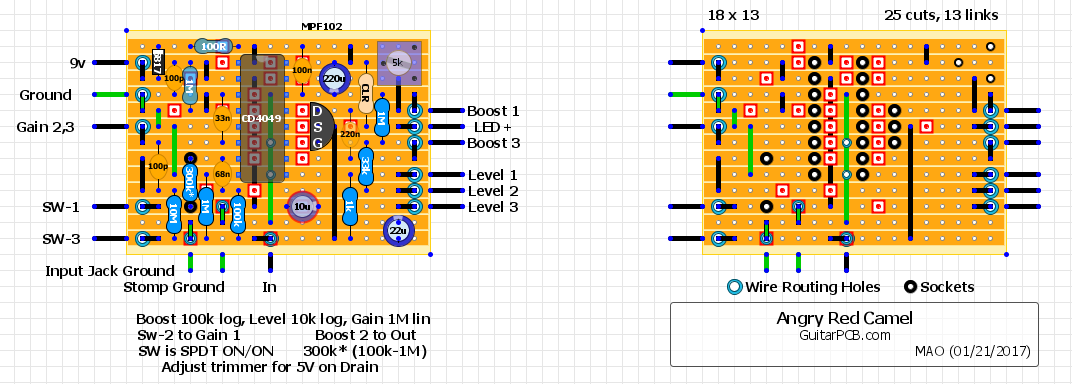
1978 Gibson Les Paul Standard, Cherry Sunburst
|
|
Administrator
|
I think the Red Llama is one of the best sounding OD/distortions I've ever heard, but they get so noisy. Have you figured a way to get the sound without the noise?
|
|
Sorry, I haven't built either the Camel or Llama as of yet, closest thing I have built was the EHX Hot Tubes and a modified TSF called the Slow Finger way back in the day.
The Slow Finger used 4 of the 4049's inverters. Hmm, I may have to look that one up again. I don't recall there being any noise with the Hot Tubes (other than a bad adapter I had at the time). I think that one has a bit more filtering though. I sold it so I can't be sure about the noise, but the guy who bought it is a noise freak, he probably would have passed on it if it was noisy. I could use a break from a couple of monster veros, I should have this one built in a couple days. Oh, and on another note, I've tied the unused 4049UBE inputs to +9 in the other builds, the Angry Camel schematic has them tied to ground. I'm hoping that's not a schematic error. But the 4049 datasheet does show some examples with them tied to ground, so I'm guessing it's ok. We'll see...
1978 Gibson Les Paul Standard, Cherry Sunburst
|
|
In reply to this post by MAO
I really like 4049 based drives. My clone of Hot Tubes is a little bit noisy.
I want to try built this, but i never understand the links in your layouts. Can you explain me? Sorry my poor english. Thanks. |
|
Hi, the color of the links is just how I keep track of the ground links, power supply links and if there is vbias. So just treat them as any other link. I often add extra, unnecessary links if they keep the off board wiring neater or if they help the components fit better.In this case, I added a couple links so I could connect the DC ground towards the top off the board , again to keep the offboard wiring short.
I also try to connect the input jack ground and stomp switch ground towards the bottom of the board to keep the off board wiring short and neat. So i usually put a couple of extra ground connections at the bottom for this purpose. The output Jack ground is connected through the metal enclosure. And I also put the input (and usually the output) connection in the middle of the bottom row, again to keep the wiring to the stomp switch short. I also now drill routing holes through the board for the wires for use as a strain relief. Sometimes I route the wires through the middle of the board, or through an existing cut like I did for the stomp switch ground on this one. The strain relief holes come in handy for neater wiring and the wires won't break off the board if you have to take it in and out of the enclosure to troubleshoot or tweak the circuit afterwards. I think I have posted a few pictures of completed boards on some of my more recent layouts that should be good examples. I'll post a picture of this one too once its completed. Hope that helps.
1978 Gibson Les Paul Standard, Cherry Sunburst
|
|
Thanks for the answer. I'll wait your pictures to understand better. Its looks very promising circuit. Cheers.
|
|
This post was updated on .
Hope these help...
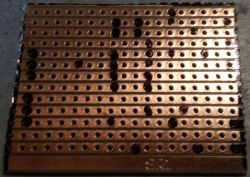    I mistakenly installed the IC socket upside down 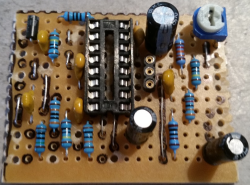 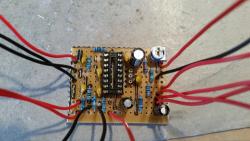 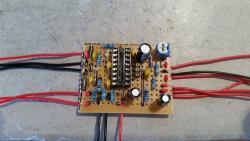 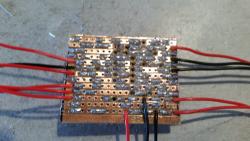
1978 Gibson Les Paul Standard, Cherry Sunburst
|
|
In reply to this post by MAO
You're fine, all that matters is that the inputs are tied to some definite logic level and not left floating. Ground and +9 are both definite logic levels and so accomplish the same thing. If there's a reference voltage somewhere tying them to that is fine too.
Through all the worry and pain we move on
|
|
Verified
I'm not clear on how the boost adds in the "original tone" as stated in the Guitarpcb video, but it does change the tone and response. I like it. The more clockwise the boost, the darker the tone. I only played it a few minutes, making sure everything was working, but so far I like the tones with the gain and level backed off a bit and the boost turned up a bit. I also like both gain switch settings, I ended up going with 300k for the lower gain resistor. 100k would allow lower gain as used in the Red Llama. With the gain, level, boost and/or gain switch full on, there's a ton of fuzz and sustain on tap. Pinch harmonics were effortless. Will be boxing this one up for sure and spending more time with it. It might be good to have the gain switch as a 2nd stomp switch for leads. Craig Anderton mentioned his original TSF design sounded best at line levels. I'm wondering how this pedal would sound stacked with itself? I'm already thinking about combining 2 layouts using 2 additional stages of the original 4049... I guess I'll build a 2nd one first and test them out together. This way I could sell the 2nd one or give it away if they don't stack well. And if it does work out well, I'll combine the layouts using a single 4049...and maybe some dual pots if it makes sense to combine any of the controls. We'll see...
1978 Gibson Les Paul Standard, Cherry Sunburst
|
|
Verified also. Great sounding pedal. Loving the darker tone you get from the boost.
Cheers Mike!
"Red velvet lines the black box"
|
|
Thanks Hoz,
I agree, sometimes I forget it doesn't have to be a monster board to sound great :0) Hoping to knock out another one this weekend to see how they stack with each other...
1978 Gibson Les Paul Standard, Cherry Sunburst
|
«
Return to Booster, OD, Fuzz, Distortion
|
1 view|%1 views
| Free forum by Nabble | Edit this page |

